A crochet cardigan is a wardrobe item that can be worn at any time of year. You can knit it yourself using a crochet hook.
Crochet patterns Both experienced and novice needlewomen can knit a cardigan. Correctly selected yarn and pattern allow you to get a beautiful and bright thing that can decorate your image.
Selecting yarn
Cardigans for each season are knitted from different types of yarn. Some crochet patterns may look sloppy if made with thick or too thin yarn. It should also be noted that in autumn and winter it is recommended to wear thick, elongated models that will help keep you warm in cold weather. In summer you can wear things knitted from cotton, linen or bamboo.
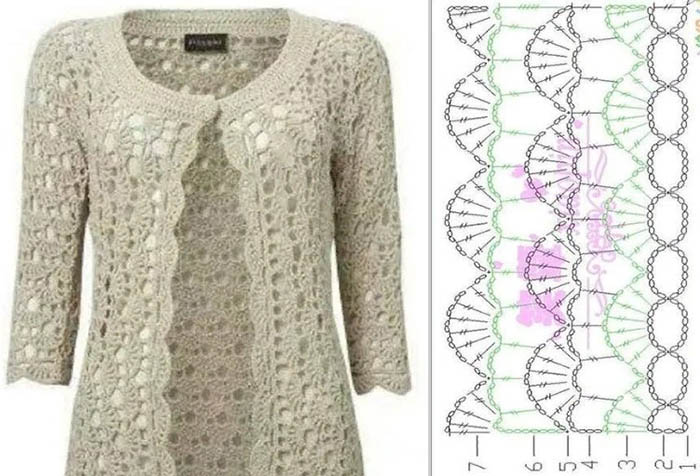
Thus, we can highlight the following materials that are used by needlewomen for crocheting a cardigan:
| Material | Material Features |
| Cotton | The thread is thin and breathable. Since it does not conduct heat well, it is mainly used to knit summer items. The material is dense and stretches slightly, so it is easy to care for such a cardigan. |
| Flax | A strong thread that absorbs moisture well and does not fade. For this reason, linen is often used to crochet summer cardigans. |
| Bamboo | The threads are strong and soft. They allow the skin to breathe, so you can also knit a cardigan for the summer from bamboo threads. |
| Merino wool | The material conducts heat well and lets moisture through. Items made from such wool can be machine washed. In addition, Australian merino wool is soft and does not cause irritation. Such yarn can be used for knitting autumn or winter cardigans. |
| Fleece | It varies in thickness and does not contain artificial components. It does not absorb liquid and does not let heat through. A summer cardigan can be knitted from a thin thread, and an autumn one from a thick thread of sheep wool. |
| Mohair | Thin yarn made of goat wool. The thread is strong, but too fluffy. For convenience, you can add sheep wool or acrylic to it. Warm spider webs are often knitted from mohair. |
| Angora | Soft threads made from Angora rabbit wool. This material is pleasant to the touch and does not cause irritation. The disadvantage of Angora is that it wears out quickly. For this reason, a cardigan made from this wool can only be worn in dry weather; rain can worsen the appearance of the finished product. |
| Silk | The yarn from these threads is very expensive, the thread is soft and shiny. Summer cardigans are knitted from it. |
| Alpaca | Light and silky yarn that does not pill. Alpaca wool threads retain heat and are uniform in composition. You can knit warm spring or autumn cardigans from such yarn. |
Artificial threads are also used for crocheting cardigans.
These include:
- acrylic;
- viscose:
- nylon
Some yarn manufacturers produce a mixture of natural and artificial threads. This improves the quality of the thread, making it stronger and smoother. An example of such a thread is a mixture of cotton and wool. Such yarn is soft and durable.
Knitting tips
Crochet patterns for a cardigan and their selection are only one of the components in working on the product. Before knitting a full-fledged product, it is recommended to determine how many skeins of yarn you should buy. This can be done in several ways. For example, you can knit a 10x10 cm sample, soak it in water, and iron it.
Next you need to:
- Measure the length and height of the sample with a ruler.
- Divide the pattern into squares the size of the knitted sample.
- Calculate how many squares the pattern consists of. Considering that the cardigan has sleeves, you need to multiply the number of squares by 2.
- Mark the first and last stitches of the sample.
- Unravel the work and measure the length of the thread.
- Multiply the measurement result by the number of squares. This step will tell you how many meters of thread you need.
- To find out the number of skeins, you need to divide the total number of meters by the amount of yarn in a single skein.
The next step in knitting is taking measurements. The cardigan will be knitted using these measurements, so it is important to take the measurements correctly.
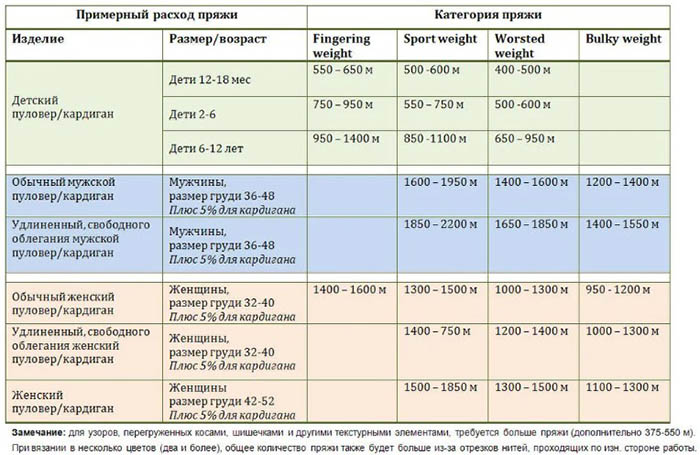
You will need to measure the following body parts:
- Chest circumference at the highest points.
- Neck circumference at its base.
- The length of the product is measured from the back to the desired length.
- Sleeve length: from the shoulder joint, along the elbow and to the wrist.
- Hip circumference at the widest points.
Cocoon cardigan
Those who are just starting to crochet, but already want to knit something for themselves, can knit a cocoon cardigan. When doing this work, there is no need to sew the parts together, since the cardigan consists of a single piece of fabric in the shape of a rectangle.
When knitting You need to decide how short or long the cardigan will be. To do this, you can put a measuring tape on your shoulders and use it to calculate the desired length of the garment. To determine the length of the sleeves, you can also measure your arms from the shoulder.
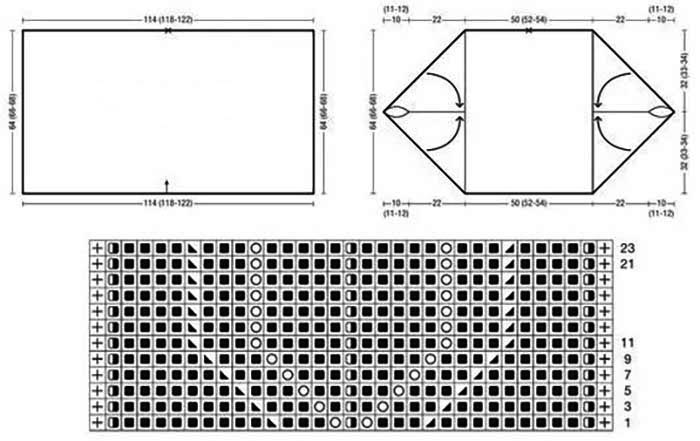
The simplest and most understandable pattern for such a cardigan is single crochet. You can knit the entire fabric with them, remembering to keep the knitting density the same. To finish the work, you need to make an air loop, pull the thread through it and cut it. You can also hide the end of the thread in the knitted fabric.
To sew the sleeves, you need to lay the fabric on a flat surface, measure the middle and fold the corners, leaving openings for the arms. This completes the knitting of the cardigan.
Openwork patterns
To knit a cardigan with an openwork pattern, you will need the number of grams of yarn corresponding to the previously taken measurements. The pattern is knitted according to the scheme, the number of loops should be a multiple of 8. Before the rapport, knit the loops, knit the pattern itself, and finish the row with loops after the rapport.
Each row begins with a lifting loop and ends with a slip stitch in 1 single crochet.
The back is knitted as follows:
- Cast on a chain of air loops and lifting loops. Knit with the basic pattern of double crochets (dc) at the beginning of the pattern, 5 dc with a common base. In this case, 4 columns out of 5 are separated by 2 air loops (ch).
- In the 1st row, 1 column is separated, and in the 2nd and subsequent even rows, the last column is separated.
- To skew the pattern on both sides, decrease by half the pattern repeat in every 20th row on both sides.
- When about 60 cm have been knitted, decrease on both sides for armholes according to the pattern.
- After 80 cm, finish knitting the back.
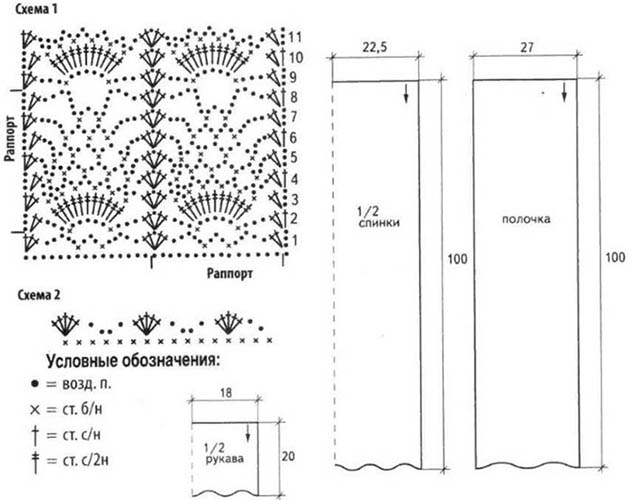
The left shelf is knitted as follows:
- Cast on a chain of ch and 3 lifting ch.
- Knit with the same pattern as the back.
- To bevel the piece on the sides, decrease on the right by half the pattern repeat in row 20.
- To form the neckline, after 70 cm from the start of the work, decrease the rapport on the left and in every 2nd row - half the rapport.
- Finish knitting after 77 cm from the beginning.
The right side is knitted symmetrically to the left side.
The sleeves are knitted with a chain of air loops and lifting loops. Then knitting continues according to the pattern of the shelves and back. After 40 cm from the beginning, the work is finished.
Assemble the cardigan according to the following pattern:
- Sew shoulder seams.
- Add sleeves. Sew sleeve seams and side seams.
- To make the cardigan look neat, tie the bottom edge, the edges of the shelves and the neckline with rows of single crochets.
An openwork cardigan can also be knitted from large motifs. For this, you can use hook number 3.25.
For sleeves 45 cm long and 30 cm wide, you will need 6 motifs respectively. For the back and the front, you will need 22 motifs. The length of such a cardigan is 54 m, the width is 90 cm. One of the motifs on the right and left fronts is beveled by half.
The beveled parts are knitted according to the following pattern:
- Start the motif with a circle of 8 loops. In the next row, cast on 12 double crochets (dc) and at the beginning of the row, cast on 3 air loops (ch).
- Row 3 consists of double crochets (dc2n) and ch.
- In the next row, you should knit arches from ch and single crochets (sc).
- The next row consists of alternating combinations of c2n and ch.
- In the penultimate row, knit an arch of 3 steps.
- Last row - at the beginning, knit a connection of 6 dc, make 2 parts of the arch from ch, then knit 6 dc, knit 2 loops and knit 6 columns again.
- Then knit 2 arches from ch, repeat the combination of 6 dc, 2 loops and 6 dc. Repeat 2 arches from ch. Finish the row with a combination of several dc, 2 ch and dc.
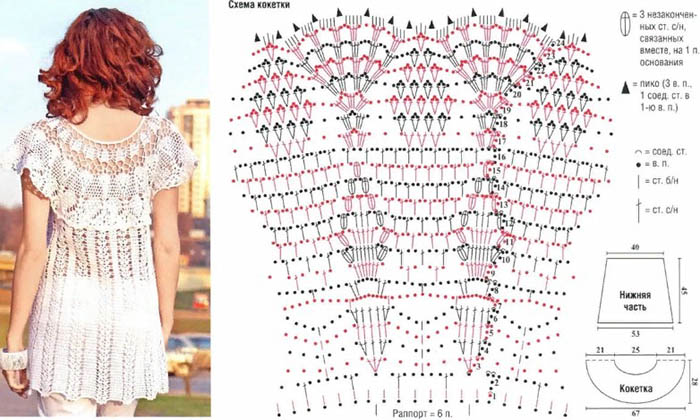
The unslanted, whole motif is a circle. When knitting, it should be taken into account that not half of the motif is knitted, but a whole circle. Both parts are knitted symmetrically, using columns with 1 and 2 yarns, ch and sc.
You can tie the hem of a cardigan using the following principle:
Knit a row of ch, in the 2nd row start knitting with sc, ch and 3 dc with a common base. After 5 loops, repeat the combination of sc, ch and 3 dc with a common base.
Summer models
Crochet patterns for a cardigan are often used for knitting summer models. So, using a simple description and diagram, you can knit a light and delicate cardigan. It will consist of motifs.
The basic pattern is knitted as follows:
- In the 1st row, knit a ring of 10 air loops (ch).
- Make a lifting loop and crochet 20 single crochets (sc) into a ring.
- Knit 3 ch, 2 double crochets (dc), 5 ch, skip 2 loops and start knitting a bunch of 3 double crochets (dc) and 5 ch.
- Knit 3 ch, 1 dc and 2 dc in the columns of the previous row. Make 4 ch. In the arch from the previous row, knit a sc. Form 4 ch, 5 columns, 1 of which is attached to the arch, 3 in the columns of the previous row and the 5th column - also in the arch. Knit 4 loops, sc, 4 ch.
- At the end of the 4th row, crochet a dc into the arch and a slip stitch into the 3rd loop from the beginning.
- In the 5th row, knit 1 dc into each column, between which knit 3 arches with 4 loops in each.
- In the 6th and last row - make a slip stitch into the next loop, knit 3 ch, dc, 7 ch, 2 dc into the same loop - knit 1 corner.
- Knit 4 arches with 4 ch. In the next corner - 2 dc, 7 ch, 2 dc - in the 3rd column of the previous row.
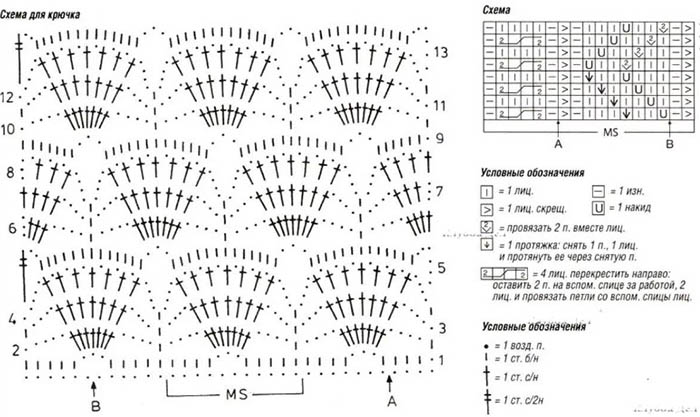
To get the back, you need to knit and sew 8 such squares. They need to be connected by the center of the arch of the 6th row. To get the sleeves, knit another 10 squares, sew the motifs to about 4 upper rows. This will form the sleeve.
In addition, for the summer months, you can knit a mesh cardigan using the following pattern:
- Knit the plank with sc.
- Knit a chain of 3 ch + 1 loop at the end of the row.
- In the 1st row, knit 4 loops, skip 2, knit dc, 2 loops, knit dc again, alternate this combination, finishing the row with dc.
- Make a lifting loop. Start row 2 with sc. In the arch of 2 ch of the previous row, knit a sc. Knit an arch of 3 loops, repeat sc and finish the row with sc in 4 ch at the beginning of row 1.
- The 3rd and subsequent rows of the main pattern alternate according to the diagram.
Floral motifs
One of the most common and popular floral motifs is the granny square. Many craftswomen use squares with such floral motifs to create cardigans.
Crochet patterns for a granny square cardigan are quick to knit and can be done by beginner knitters.
This requires:
- Yarn for flower and background
- Hook for the thickness of the yarn
- Scissors
- Yarn needle

You need to start working by knitting the core.
- Knit a ring of 5 loops, knit 15 double crochets (dc) into the ring and close them as well. If everything is done correctly, 16 loops will be closed into the ring.
- Make a chain stitch (ch), cut the thread, pull it through the loop and tighten. If necessary, trim the tail to a length of 5 - 7 cm.
- Fasten the thread of the second color on the circle of loops. From the nearest loop, knit 3 air loops, and then a lush double sl. After it, knit a ch. In the adjacent loop, knit a triple lush sl. Repeat ch. Continue until the circle is closed. Fasten the thread in the same way as the thread of the 1st color was fastened.
- A row of flower petals should be knitted with lush columns of 4 half columns. Between these columns, not 1, but 2 VP are added. Fasten the thread at the end of knitting.
- To form a square, secure a new thread and insert it under the ch of the previous row. Knit 3 dc from 1 loop, then from the next hole knit 3 half-columns with 1 yarn over. From the same hole knit 3 dc.
- From the next loop, knit 3 or 2 double crochets (dc2n). Knit 2 or 3 loops, repeat 2 or 3 dc2n.
- Continue the circle, knitting according to point 6. Close the row. Check how all the threads are secured.
Patterns from thin threads
Crochet patterns for a cardigan can be knitted from thin threads. Often, openwork cardigans are knitted this way. Also, a cardigan can be knitted using the fillet technique from thin threads. In the fillet knitting pattern from thin threads, a cell without a cross means a double crochet and an air loop. A cell with a cross means 2 double crochets.
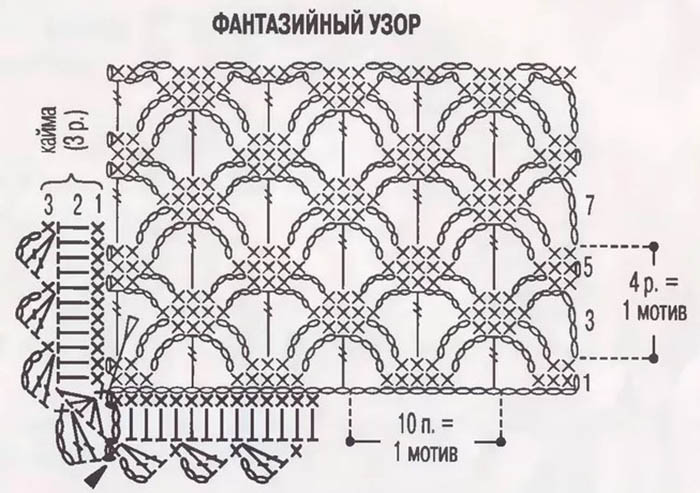
Thus, any crochet patterns are used to create a cardigan. For example, for summer days, you can knit a light and airy cardigan from cotton yarn with an openwork pattern. Many needlewomen knit cardigans from thick and dense yarn that retain heat.
Video about patterns
Master-krass: Cardigan crochet for beginners:
